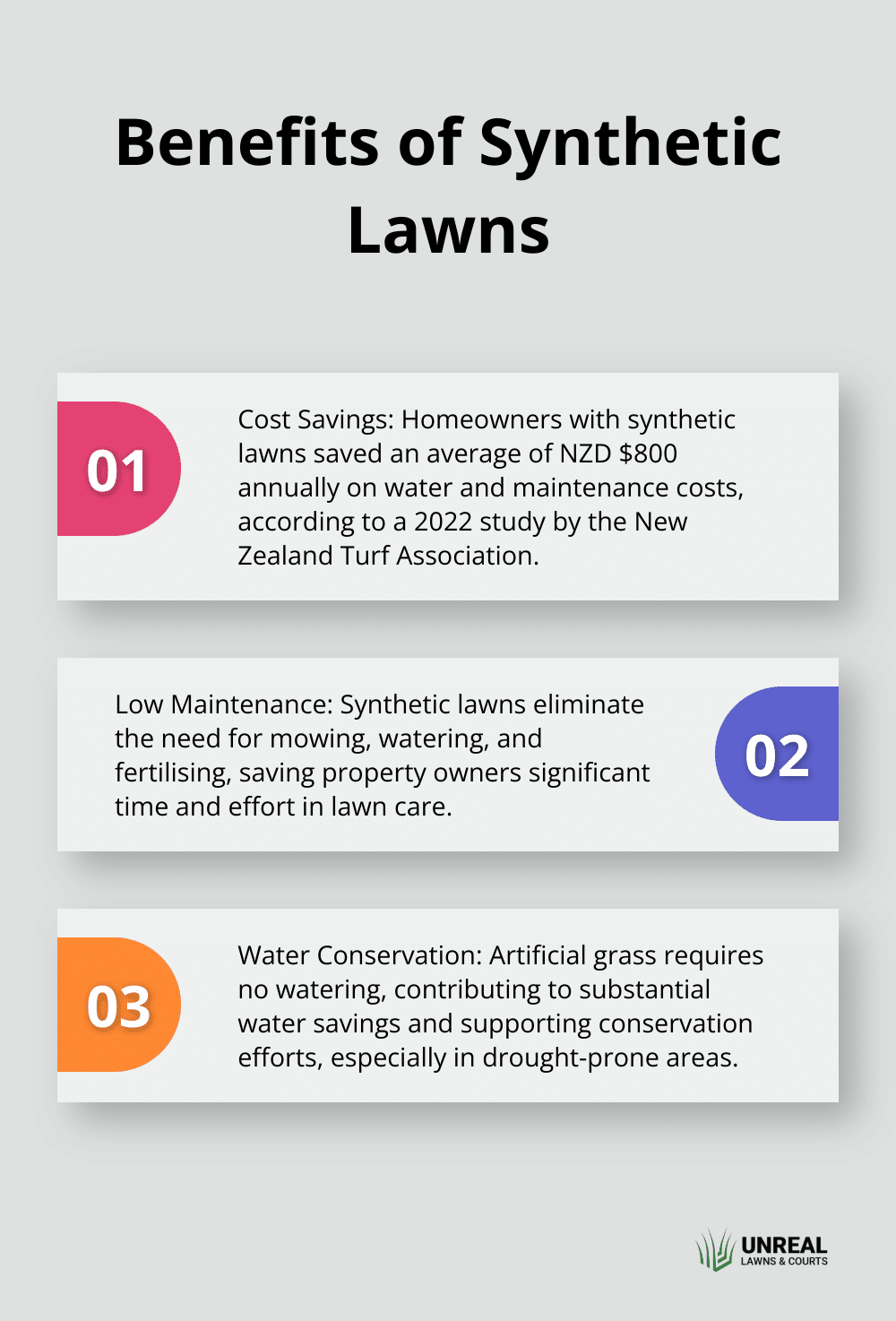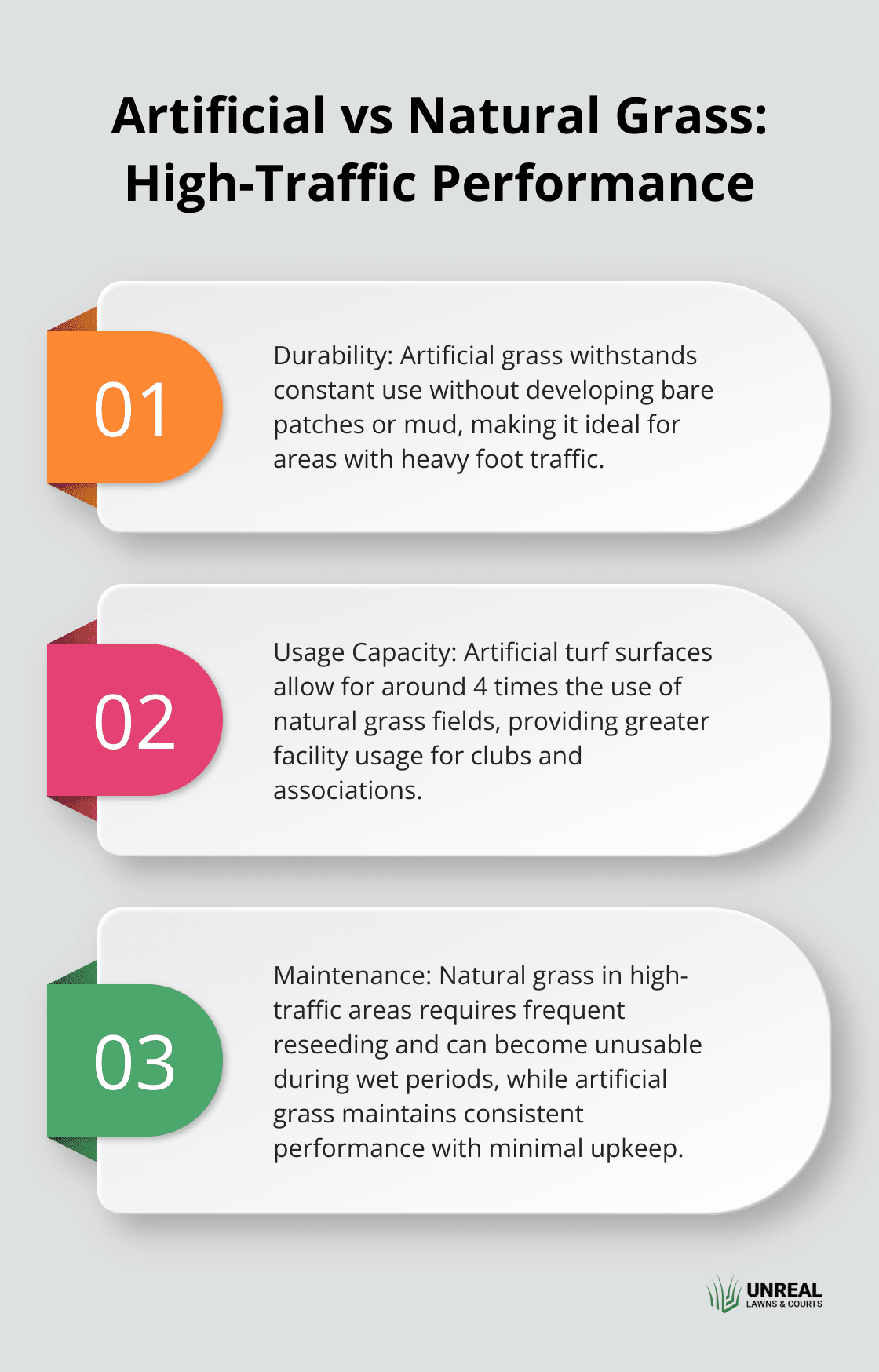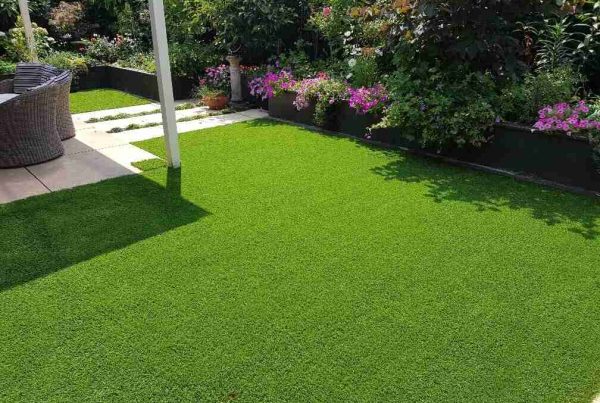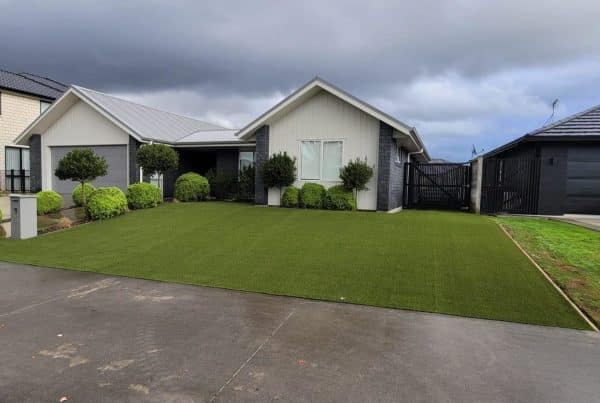At Unreal Lawns & Courts, we often get asked about the pros and cons of fake grass vs. real grass. It’s a decision that can significantly impact your outdoor space, maintenance routine, and even your wallet.
In this post, we’ll break down the advantages of both artificial and natural grass, helping you make an informed choice for your specific needs.
Why Artificial Grass Wins the Maintenance Game
Low Maintenance: A Game-Changer
Artificial grass revolutionises outdoor spaces with its incredibly low maintenance requirements. Property owners can forget about mowing, watering, and fertilising. This time-saving feature transforms the lives of busy homeowners and businesses. A 2022 study by the New Zealand Turf Association found that homeowners with synthetic lawns saved an average of NZD $800 annually on water and maintenance costs.

Year-Round Green Perfection
Artificial grass maintains a lush, green appearance regardless of the season. This consistency proves particularly valuable in areas with harsh winters or scorching summers (where natural grass struggles to thrive). You’ll enjoy a picture-perfect lawn every day of the year without lifting a finger.
Water Conservation Champion
In an era of increasing water scarcity, artificial grass stands out as a water-wise solution. Front yard synthetic grass requires no water, reducing household water usage by thousands of liters each year. Switching to artificial grass significantly reduces water usage and contributes to conservation efforts.
Durability That Lasts
Artificial turf’s durability sets it apart from natural grass. High-quality synthetic grass can last up to 15-20 years with proper care, far outlasting natural grass in high-traffic areas. This longevity translates to substantial cost savings over time, despite the higher initial investment.
Pet-Friendly Features
For pet owners, artificial grass offers unique benefits. It resists digging, doesn’t turn yellow from pet urine, and cleans easily. Many artificial grass products also feature antimicrobial properties, which help keep outdoor spaces hygienic and reduce odour.
The advantages of artificial grass extend beyond maintenance. Its ability to withstand heavy use makes it an ideal choice for various settings, from residential backyards to commercial spaces. As we explore the benefits of natural grass in the next section, you’ll gain a comprehensive understanding of both options to make an informed decision for your outdoor space.
Why Natural Grass Remains a Popular Choice
Natural grass continues to be a favoured option for many homeowners and landscapers, despite the rise of artificial alternatives. Its unique qualities offer several advantages that synthetic options can’t replicate.
The Environmental Powerhouse
Natural grass offers numerous environmental benefits, from reducing carbon emissions to improving air and water quality. It absorbs carbon dioxide, releases oxygen, and filters pollutants from the air and water.
Nature’s Air Conditioner
One of the most underappreciated benefits of natural grass is its cooling effect. On hot summer days, grass lawns can be up to 30 degrees Celsius cooler than asphalt and 14 degrees cooler than bare soil. This natural cooling mechanism can significantly reduce energy costs for air conditioning in nearby buildings.
A Haven for Biodiversity
Natural lawns support a diverse range of insects, birds, and small animals. A healthy lawn can host over 100 different species of insects (providing a crucial link in the local food chain). For gardeners who want to attract pollinators or create a wildlife-friendly space, natural grass is the clear winner.
Low Initial Cost
The initial cost of installing natural grass is typically lower than that of artificial turf. This makes it an attractive option for those working with a tight budget or covering large areas. Seeds or sod can be relatively inexpensive, especially when compared to the upfront costs of synthetic alternatives.
Aesthetic Appeal and Texture
Many people prefer the look and feel of natural grass. The soft texture underfoot and the subtle variations in colour throughout the seasons create a dynamic, living landscape. This aesthetic appeal can enhance property value and create a more inviting outdoor space.
While artificial grass has its merits, natural grass offers unique benefits that are hard to replicate. The choice between the two often comes down to individual priorities and specific site conditions. In the next section, we’ll compare artificial and natural grass side by side to help you make an informed decision for your specific needs.
Fake Grass vs Natural Grass: The Ultimate Showdown
The Cost Conundrum
Initial installation costs for artificial grass exceed those of natural grass. In New Zealand, high-quality synthetic turf (including installation) costs approximately NZD $100-150 per square metre. Natural grass sod installation, in contrast, ranges from NZD $10-20 per square metre.
The long-term financial picture paints a different story. Natural grass demands ongoing expenses for mowing, watering, fertilising, and pest control. These costs can total NZD $1,000-2,000 annually for an average-sized lawn. Artificial grass maintenance costs remain minimal, often below NZD $100 per year.
Environmental Considerations
Natural grass functions as a carbon sink, absorbing CO2 and releasing oxygen. It also provides a habitat for insects and small animals. However, it requires significant water usage – up to 550 litres per square metre annually in dry climates.
Artificial grass conserves water and eliminates the need for chemical fertilisers and pesticides. However, it consists of non-biodegradable materials and can contribute to heat island effects in urban areas.
Climate Adaptability
Natural grass thrives in temperate climates with regular rainfall. It struggles in extreme heat or cold, and in drought-prone areas. Artificial grass performs consistently across all climates, making it ideal for regions with water restrictions or harsh weather conditions.
High-Traffic Performance
For areas with heavy foot traffic, artificial grass stands out as the clear winner. It withstands constant use without developing bare patches or mud. Natural grass in high-traffic areas requires frequent reseeding and can become unusable during wet periods.
In sports applications, many professional teams now prefer artificial turf for its durability and consistent playing surface. Artificial turf surfaces allow for around 4 times the use of natural grass fields, providing clubs and associations with facilities to cater for greater usage.
The Aesthetic Factor
While high-quality artificial grass can look remarkably realistic, some people still prefer the subtle colour variations and texture of natural grass. The choice often depends on personal preference and the specific needs of your space (e.g., low maintenance vs. traditional aesthetics).

Final Thoughts
The fake grass vs real grass debate hinges on individual needs, preferences, and circumstances. Artificial grass offers low maintenance, consistent appearance, and water conservation, making it ideal for high-traffic areas or regions with water restrictions. Natural grass provides environmental benefits, supports biodiversity, and creates a natural cooling effect, appealing to those who prefer a traditional lawn aesthetic.
Your decision should factor in lifestyle, budget, local climate, and the intended use of your outdoor space. Consider the time you want to invest in lawn care, your water usage concerns, and the desired look for your property. These factors will guide you towards the best choice for your specific situation.
At Unreal Lawns & Courts, we offer premium synthetic turf solutions that combine aesthetics with functionality. Our artificial grass products provide a lush, green appearance year-round without the need for watering, mowing, or fertilising. We have options to suit various needs and budgets for residential backyards, commercial spaces, and sports fields.

![Fake Grass vs. Real Grass [Which is Right for You?]](https://unreallawns.co.nz/wp-content/uploads/2025/09/fake-grass-vs-real-grass-1750993718.jpeg)



